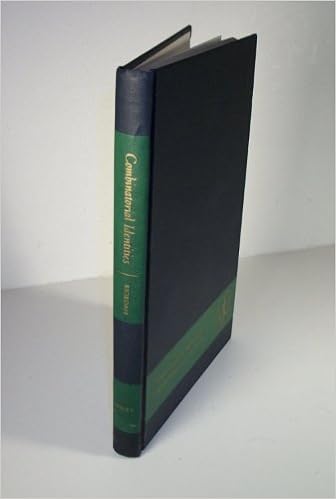
This revised and enlarged 5th version positive aspects 4 new chapters, which comprise hugely unique and pleasant proofs for classics corresponding to the spectral theorem from linear algebra, a few newer jewels just like the non-existence of the Borromean jewelry and different surprises.
From the Reviews
"... within PFTB (Proofs from The ebook) is certainly a glimpse of mathematical heaven, the place smart insights and lovely rules mix in magnificent and wonderful methods. there's gigantic wealth inside its pages, one gem after one other. ... Aigner and Ziegler... write: "... all we provide is the examples that we've got chosen, hoping that our readers will proportion our enthusiasm approximately significant rules, smart insights and beautiful observations." I do. ... "
Notices of the AMS, August 1999
"... This publication is a excitement to carry and to examine: considerable margins, great images, instructive images and gorgeous drawings ... it's a excitement to learn in addition: the fashion is apparent and pleasing, the extent is with reference to simple, the mandatory history is given individually and the proofs are superb. ..."
LMS e-newsletter, January 1999
"Martin Aigner and Günter Ziegler succeeded admirably in placing jointly a vast selection of theorems and their proofs that will absolutely be within the publication of Erdös. The theorems are so primary, their proofs so dependent and the rest open questio
ns so fascinating that each mathematician, despite speciality, can make the most of interpreting this booklet. ... "
SIGACT information, December 2011.
Read Online or Download Proofs from THE BOOK PDF
Similar Combinatorics books
Finite Projective Spaces of Three Dimensions (Oxford Mathematical Monographs)
This self-contained and hugely special learn considers projective areas of 3 dimensions over a finite box. it's the moment and center quantity of a three-volume treatise on finite projective areas, the 1st quantity being Projective Geometrics Over Finite Fields (OUP, 1979). the current paintings restricts itself to 3 dimensions, and considers either subject matters that are analogous of geometry over the complicated numbers and subject matters that come up out of the fashionable idea of prevalence buildings.
Applied Combinatorics With Problem Solving
Booklet by way of Jackson, Bradley, Thoro, Dmitri
Mathematics as Problem Solving
Quite a few effortless ideas for fixing difficulties in algebra, geometry, and combinatorics are explored during this moment variation of arithmetic as challenge fixing. every one new bankruptcy builds at the past one, permitting the reader to discover new equipment for utilizing common sense to resolve problems. Topics are presented in self-contained chapters, with classical options in addition to Soifer's personal discoveries.
Combinatorial Identities (Wiley Series in Probability and Mathematical Statistics)
COMBINATORIAL IDENTITIES explores the opportunity of discovering components of order and coherence in combinatorial identitiesâ€"identities among, or by way of, combinatorial entitiesâ€"within mathematical settings. simply because this can be a obviously chaotic topic, a number of divergent yet comparable themes seem within the dialogue.
Extra info for Proofs from THE BOOK
P−1 2 }. for this reason 2 (−ui ) i vj = p−1 2 ! , j which means (−1)s vj ≡ ui i p−1 2 ! (mod p). j Now bear in mind how we acquired the numbers ui and vj ; they're the residues of 1a, · · · , p−1 2 a. accordingly p−1 2 ! ≡ (−1)s i Cancelling p−1 2 ! vj ≡ (−1)s ui p−1 p−1 2 2 ! a (mod p). j including Euler’s criterion provides p−1 a ( ) ≡ a 2 ≡ (−1)s (mod p), p and accordingly ( ap ) = (−1)s , because p is atypical. With this we will be able to simply compute ( p2 ): given that 1 · 2, 2 · 2, . . . , p−1 2 · 2 are all among 1 and p − 1, now we have s = #{i : p−1 2 < 2i ≤ p − 1} = p−1 2 − #{i : 2i ≤ p−1 2 } = p−1 four . cost that s is even accurately for p = 8k ± 1. The Lemma of Gauss is the root for lots of of the broadcast proofs of the quadratic reciprocity legislation. the main stylish could be the one urged by means of Ferdinand Gotthold Eisenstein, who had realized quantity idea from Gauss’ well-known Disquisitiones Arithmeticae and made vital contributions to “higher reciprocity theorems” prior to his untimely loss of life at age 29. His evidence is simply counting lattice issues! If −ui = vj , then ui + vj ≡ zero (mod p). Now ui ≡ ka, vj ≡ a (mod p) implies p | (k + )a. As p and a are really best, p needs to divide ok + that's most unlikely, due to the fact ok + ≤ p − 1. 26 The legislations of quadratic reciprocity enable p and q be extraordinary primes, and view ( pq ). feel iq is a a number of of q that reduces to a unfavorable residue ri < zero within the Lemma of Gauss. which means there's a detailed integer j such that − p2 < iq − jp < zero. word that zero < j < q2 when you consider that zero < i < p2 . In different phrases, ( pq ) = (−1)s , the place s is the variety of lattice issues (x, y), that's, pairs of integers x, y enjoyable zero < py − qx < p p q , 0



